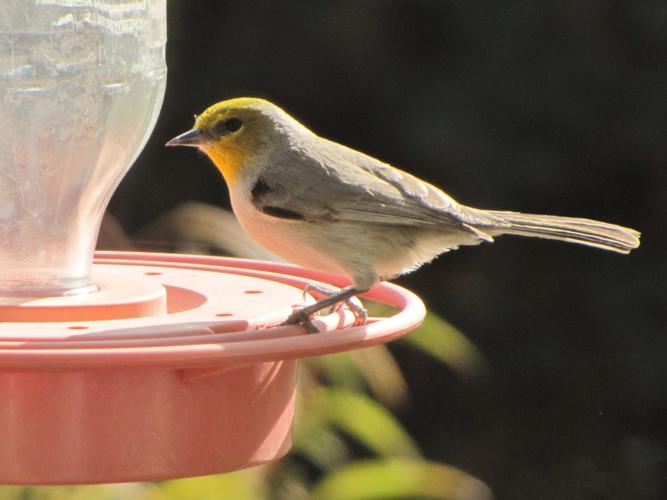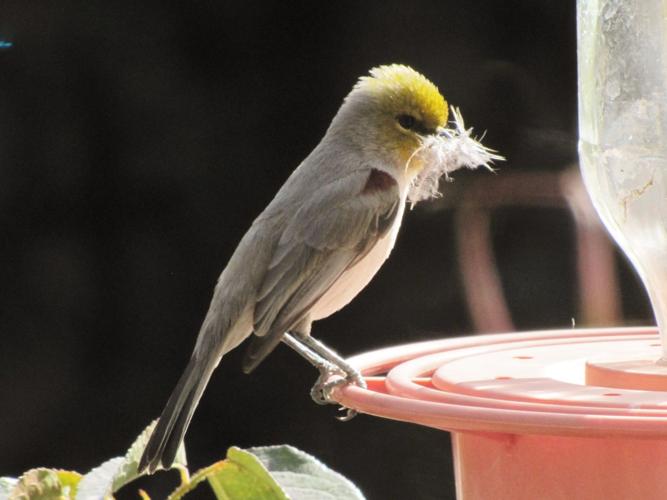The Verdin is one of my favorite Southeast Arizona birds. This tiny 4-inch bird is inquisitive and friendly and will brighten anyone’s day. Unless you get a good look at a Verdin in the sunlight, you might easily mistake him for a small sparrow, finch or just another unidentifiable little gray bird. Get a better look, however, and there is no mistaking that beautiful yellow face and red shoulder patches.
As with a number of special birds, we are especially lucky to have Verdins, since their U.S. range is quite limited. Found throughout Mexico, where it is known as the Baloncillo, Verdins are only found in the southern sections of five states: Texas, New Mexico, Nevada, California and Arizona. Verdins are permanent year-round residents wherever they live, preferring warm deserts, and refusing to migrate, just like the hardiest SaddleBrooke homeowners.
The Verdin (Auriparus flaviceps) is a member of the Remizidae family and the genus Auriparus. It is the only species in the genus, and the only species in the family found in the New World. It is also one of the smallest passerines (perching songbirds) in North America. It is gray overall, and the adult birds have a bright yellow head and throat, as well as those sometimes hard-to-see rufous-red shoulder epaulets (lesser coverts). Its size and movements remind one of Bushtits and Chickadees, although it isn’t found in flocks like Bushtits, and its bill is longer and more sharply pointed than Bushtits. Juvenile Verdins more closely resemble Bushtits, since they are gray overall without the yellow head and reddish shoulder. Adult male and female Verdins are essentially identical in appearance, and often travel and feed together.
Like Cactus Wrens, Verdins will build several nests each year, including smaller ones for winter roosting. The male builds more than one nest of twigs, and the female selects her favorite. Females line the nests with feathers and down, so one of the few ways to distinguish males from females is to observe nest-building. If a Verdin is carrying twigs to the nest, it’s likely a male, but if the bird has down or fluff in her bill, it’s a female. Verdin nests are unique football-shaped baskets with a small opening near the bottom, giving the occupants more protection than an open cup-like nest. Nests are often built in mesquites and cholla cactus, although we’ve found their nests in a wide variety of trees. The female lays three to six eggs, which incubate in ten days, and the young fledge in three weeks. Juveniles have none of the adult feather color but can be differentiated from similar gray birds by their pinkish-yellow lower bill.
Although Verdins are insectivorous, they also eat seeds and fruit, and are nectar-eaters, as well. They flit acrobatically through branches gleaning insects but are equally attracted to nectar-rich hummingbird plants like fairy duster, salvia, and honeysuckle. Verdins also frequent hummingbird feeders, picking dried sugar water from the feeders’ nooks and crannies. One sure-fire way to attract Verdins is to plant a Pomegranate tree. Verdins will clean a split Pomegranate, leaving nothing but the shell. If you don’t want to plant a tree, buy a Pomegranate at the grocery store, cut it in half and impale the halves on a finishing nail driven into a tree stake. Pomegranates can cost $3 a piece, but once Verdins start visiting, you’ll be glad you shelled it out. They’ll even perch on your windowsill to say thanks.








